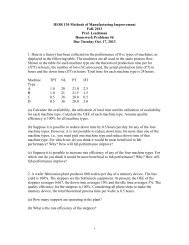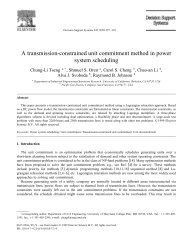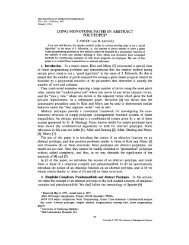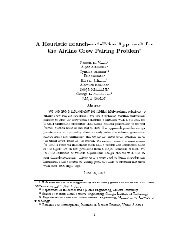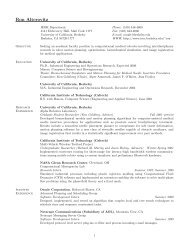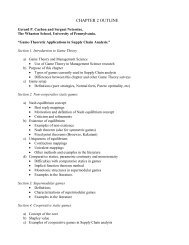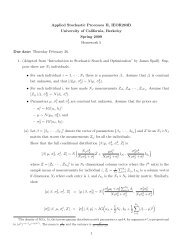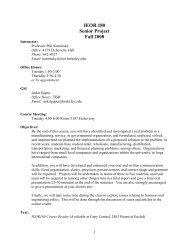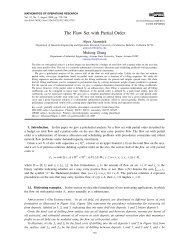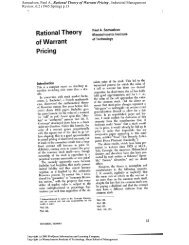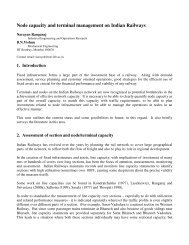IEOR 269, Spring 2010 Integer Programming and Combinatorial ...
IEOR 269, Spring 2010 Integer Programming and Combinatorial ...
IEOR 269, Spring 2010 Integer Programming and Combinatorial ...
Create successful ePaper yourself
Turn your PDF publications into a flip-book with our unique Google optimized e-Paper software.
<strong>IEOR</strong><strong>269</strong> notes, Prof. Hochbaum, <strong>2010</strong> 3<br />
otherwise. This is illustrated for the case of n = 3 in equation (3), where the columns of A are<br />
ordered in lexicographic order for (i, j) ∈ {1, . . . , n} 2 .<br />
⎛<br />
⎞<br />
1 1 1 0 0 0 0 0 0<br />
0 0 0 1 1 1 0 0 0<br />
A =<br />
0 0 0 0 0 0 1 1 1<br />
⎜1 0 0 1 0 0 1 0 0<br />
⎟<br />
⎝0 1 0 0 1 0 0 1 0⎠<br />
0 0 1 0 0 1 0 0 1<br />
<strong>and</strong> if we note b = ( 1, 1, 1, 1, 1, 1, 1, 1, 1 ) T <strong>and</strong> X =<br />
(<br />
x1,1 , x 1,2 , x 1,3 , . . . , x 3,1 , x 3,2 , x 3,3<br />
) T the constraints<br />
(1)- (2) in the case of n = 3 can be rewritten as AX = b.<br />
This property of the constraint matrix can be used to show that the solutions of the LPrelaxation<br />
of the assignment problem are integers.<br />
Definition 2.1. A matrix A is called totally unimodular (TUM) if for any square sub-matrix A ′<br />
of A, det A ′ ∈ {−1, 0, 1}.<br />
Lemma 2.2. The solutions of a LP with integer objective, integer right-h<strong>and</strong> side constraint, <strong>and</strong><br />
TUM constraint matrix are integers.<br />
Proof. Consider a LP in classical form:<br />
max c T x<br />
subject to A x ≤ b<br />
where c, x ∈ Z n , A ∈ Z m×n totally unimodular, b ∈ Z m . If m < n, a basic solution x ∗ basic<br />
of the<br />
LP is given by x ∗ basic = B−1 b where B = (b i,j ) 1≤i,j≤m is a non-singular square submatrix of A<br />
(columns of B are not necessarily consecutive columns of A).<br />
Using Cramer’s rule, we can write: B −1 = C T / det B where C = (c i,j ) denotes the cofactor<br />
matrix of B. As detailed in (4), the absolute value of c i,j is the determinant of the matrix obtained<br />
by removing line i <strong>and</strong> column j from B.<br />
⎛<br />
⎞<br />
b 1,1 . . . b 1,j−1 X b 1,j+1 . . . b 1,m<br />
. . . . . . .<br />
c i,j = (−1) i+j b i−1,1 . . . b i−1,j−1 X b i−1,j+1 . . . b i−1,m<br />
det<br />
X X X X X X X<br />
(4)<br />
b i+1,1 . . . b i+1,j−1 X b i+1,j+1 . . . b i+1,m<br />
⎜<br />
⎟<br />
⎝ . . . . . . . ⎠<br />
b m,1 . . . b m,j−1 X b m,j+1 . . . b m,m<br />
Since det(·) is a polynomial function of the matrix coefficients, if B has integer coefficients, so does<br />
C. If A is TUM, since B is non-singular, det(B) ∈ {−1, 1} so B −1 has integer coefficients. If b has<br />
integer coefficients, so does the optimal solution of the LP.<br />
ILP with TUM constraint matrix can be solved by considering their LP relaxation, whose solutions<br />
are integral. The minimum cost network flow problem has a TUM constraint matrix.<br />
(3)




